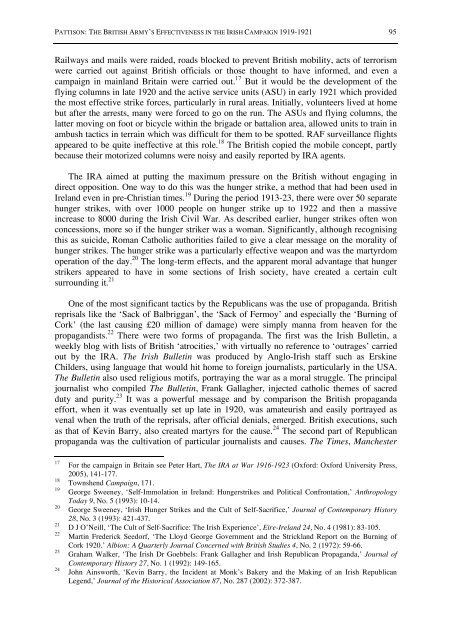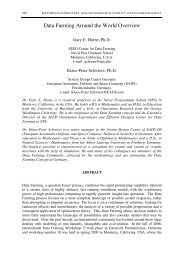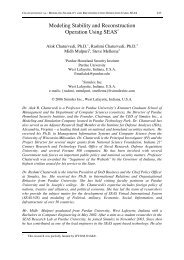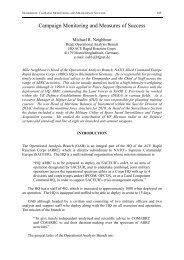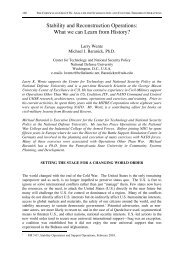The British Army's Effectiveness in the Irish ... - Cornwallis Group
The British Army's Effectiveness in the Irish ... - Cornwallis Group
The British Army's Effectiveness in the Irish ... - Cornwallis Group
Create successful ePaper yourself
Turn your PDF publications into a flip-book with our unique Google optimized e-Paper software.
PATTISON: THE BRITISH ARMY’S EFFECTIVENESS IN THE IRISH CAMPAIGN 1919-1921 95<br />
Railways and mails were raided, roads blocked to prevent <strong>British</strong> mobility, acts of terrorism<br />
were carried out aga<strong>in</strong>st <strong>British</strong> officials or those thought to have <strong>in</strong>formed, and even a<br />
campaign <strong>in</strong> ma<strong>in</strong>land Brita<strong>in</strong> were carried out. 17 But it would be <strong>the</strong> development of <strong>the</strong><br />
fly<strong>in</strong>g columns <strong>in</strong> late 1920 and <strong>the</strong> active service units (ASU) <strong>in</strong> early 1921 which provided<br />
<strong>the</strong> most effective strike forces, particularly <strong>in</strong> rural areas. Initially, volunteers lived at home<br />
but after <strong>the</strong> arrests, many were forced to go on <strong>the</strong> run. <strong>The</strong> ASUs and fly<strong>in</strong>g columns, <strong>the</strong><br />
latter mov<strong>in</strong>g on foot or bicycle with<strong>in</strong> <strong>the</strong> brigade or battalion area, allowed units to tra<strong>in</strong> <strong>in</strong><br />
ambush tactics <strong>in</strong> terra<strong>in</strong> which was difficult for <strong>the</strong>m to be spotted. RAF surveillance flights<br />
appeared to be quite <strong>in</strong>effective at this role. 18 <strong>The</strong> <strong>British</strong> copied <strong>the</strong> mobile concept, partly<br />
because <strong>the</strong>ir motorized columns were noisy and easily reported by IRA agents.<br />
<strong>The</strong> IRA aimed at putt<strong>in</strong>g <strong>the</strong> maximum pressure on <strong>the</strong> <strong>British</strong> without engag<strong>in</strong>g <strong>in</strong><br />
direct opposition. One way to do this was <strong>the</strong> hunger strike, a method that had been used <strong>in</strong><br />
Ireland even <strong>in</strong> pre-Christian times. 19 Dur<strong>in</strong>g <strong>the</strong> period 1913-23, <strong>the</strong>re were over 50 separate<br />
hunger strikes, with over 1000 people on hunger strike up to 1922 and <strong>the</strong>n a massive<br />
<strong>in</strong>crease to 8000 dur<strong>in</strong>g <strong>the</strong> <strong>Irish</strong> Civil War. As described earlier, hunger strikes often won<br />
concessions, more so if <strong>the</strong> hunger striker was a woman. Significantly, although recognis<strong>in</strong>g<br />
this as suicide, Roman Catholic authorities failed to give a clear message on <strong>the</strong> morality of<br />
hunger strikes. <strong>The</strong> hunger strike was a particularly effective weapon and was <strong>the</strong> martyrdom<br />
operation of <strong>the</strong> day. 20 <strong>The</strong> long-term effects, and <strong>the</strong> apparent moral advantage that hunger<br />
strikers appeared to have <strong>in</strong> some sections of <strong>Irish</strong> society, have created a certa<strong>in</strong> cult<br />
surround<strong>in</strong>g it. 21<br />
One of <strong>the</strong> most significant tactics by <strong>the</strong> Republicans was <strong>the</strong> use of propaganda. <strong>British</strong><br />
reprisals like <strong>the</strong> ‘Sack of Balbriggan’, <strong>the</strong> ‘Sack of Fermoy’ and especially <strong>the</strong> ‘Burn<strong>in</strong>g of<br />
Cork’ (<strong>the</strong> last caus<strong>in</strong>g £20 million of damage) were simply manna from heaven for <strong>the</strong><br />
propagandists. 22 <strong>The</strong>re were two forms of propaganda. <strong>The</strong> first was <strong>the</strong> <strong>Irish</strong> Bullet<strong>in</strong>, a<br />
weekly blog with lists of <strong>British</strong> ‘atrocities,’ with virtually no reference to ‘outrages’ carried<br />
out by <strong>the</strong> IRA. <strong>The</strong> <strong>Irish</strong> Bullet<strong>in</strong> was produced by Anglo-<strong>Irish</strong> staff such as Ersk<strong>in</strong>e<br />
Childers, us<strong>in</strong>g language that would hit home to foreign journalists, particularly <strong>in</strong> <strong>the</strong> USA.<br />
<strong>The</strong> Bullet<strong>in</strong> also used religious motifs, portray<strong>in</strong>g <strong>the</strong> war as a moral struggle. <strong>The</strong> pr<strong>in</strong>cipal<br />
journalist who compiled <strong>The</strong> Bullet<strong>in</strong>, Frank Gallagher, <strong>in</strong>jected catholic <strong>the</strong>mes of sacred<br />
duty and purity. 23 It was a powerful message and by comparison <strong>the</strong> <strong>British</strong> propaganda<br />
effort, when it was eventually set up late <strong>in</strong> 1920, was amateurish and easily portrayed as<br />
venal when <strong>the</strong> truth of <strong>the</strong> reprisals, after official denials, emerged. <strong>British</strong> executions, such<br />
as that of Kev<strong>in</strong> Barry, also created martyrs for <strong>the</strong> cause. 24 <strong>The</strong> second part of Republican<br />
propaganda was <strong>the</strong> cultivation of particular journalists and causes. <strong>The</strong> Times, Manchester<br />
17 For <strong>the</strong> campaign <strong>in</strong> Brita<strong>in</strong> see Peter Hart, <strong>The</strong> IRA at War 1916-1923 (Oxford: Oxford University Press,<br />
2005), 141-177.<br />
18 Townshend Campaign, 171.<br />
19 George Sweeney, ‘Self-Immolation <strong>in</strong> Ireland: Hungerstrikes and Political Confrontation,’ Anthropology<br />
Today 9, No. 5 (1993): 10-14.<br />
20 George Sweeney, ‘<strong>Irish</strong> Hunger Strikes and <strong>the</strong> Cult of Self-Sacrifice,’ Journal of Contemporary History<br />
28, No. 3 (1993): 421-437.<br />
21 D J O’Neill, ‘<strong>The</strong> Cult of Self-Sacrifice: <strong>The</strong> <strong>Irish</strong> Experience’, Eire-Ireland 24, No. 4 (1981): 83-105.<br />
22 Mart<strong>in</strong> Frederick Seedorf, ‘<strong>The</strong> Lloyd George Government and <strong>the</strong> Strickland Report on <strong>the</strong> Burn<strong>in</strong>g of<br />
Cork 1920.’ Albion: A Quarterly Journal Concerned with <strong>British</strong> Studies 4, No. 2 (1972): 59-66.<br />
23 Graham Walker, ‘<strong>The</strong> <strong>Irish</strong> Dr Goebbels: Frank Gallagher and <strong>Irish</strong> Republican Propaganda,’ Journal of<br />
Contemporary History 27, No. 1 (1992): 149-165.<br />
24 John A<strong>in</strong>sworth, ‘Kev<strong>in</strong> Barry, <strong>the</strong> Incident at Monk’s Bakery and <strong>the</strong> Mak<strong>in</strong>g of an <strong>Irish</strong> Republican<br />
Legend,’ Journal of <strong>the</strong> Historical Association 87, No. 287 (2002): 372-387.


